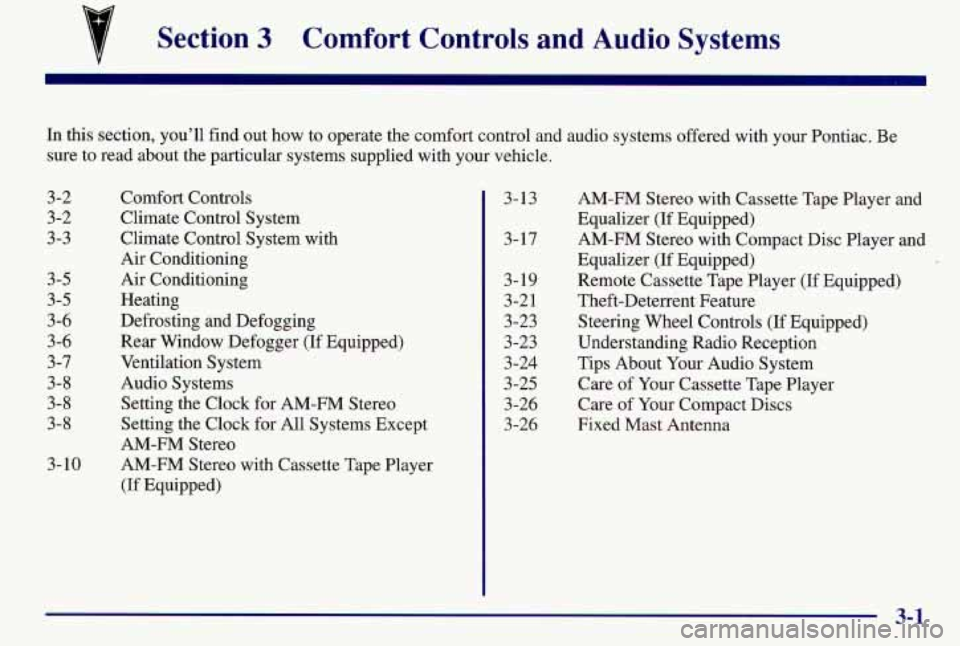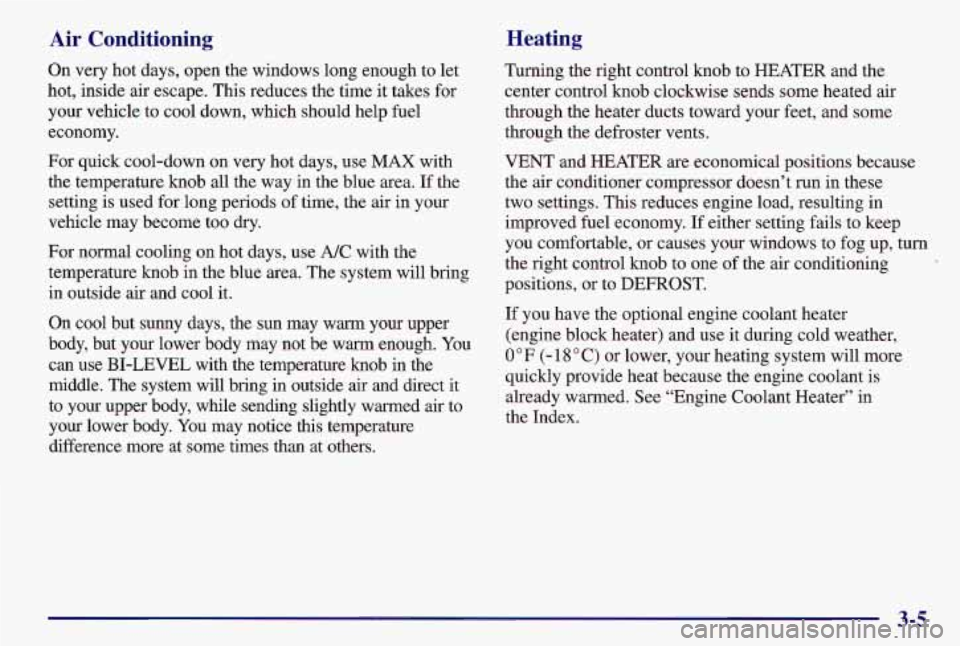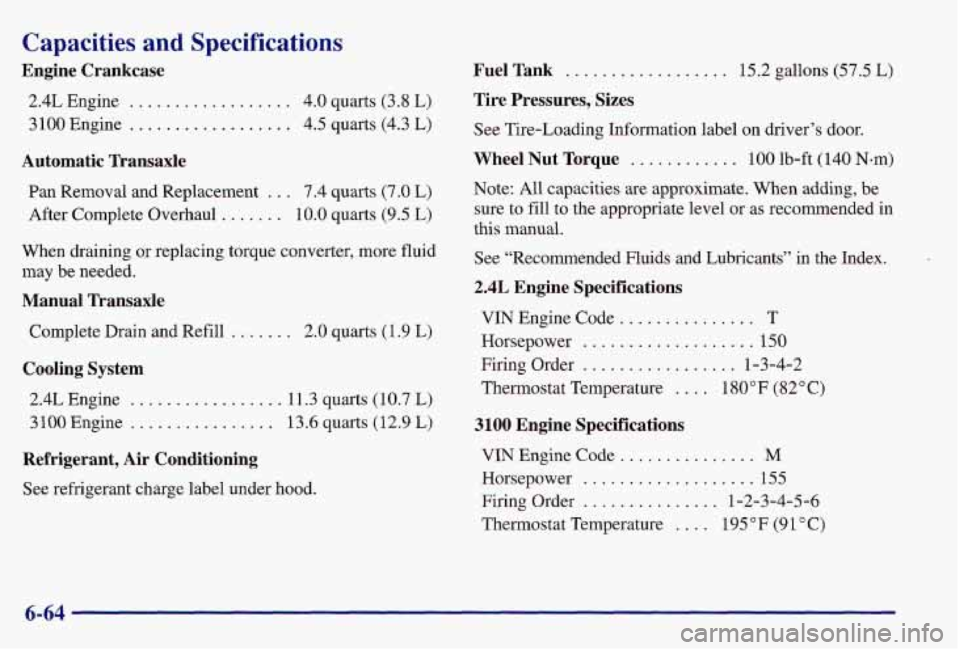Page 126 of 371

Section 3 Comfort Controls and Audio Systems
In this section, you’ll find out how to operate the comfort control and audio systems offered with your Pontiac. Be
sure to read about the particular systems supplied with your vehicle.
3-2
3-2
3-3 3-5
3-5
3-6 3-6
3-7
3-8 3-8
3-8
3-10 Comfort Controls
Climate Control System
Climate Control System with
Air
Conditioning
Air Conditioning
Heating
Defrosting and Defogging
Rear Window Defogger (If Equipped)
Ventilation System
Audio Systems
Setting the Clock for AM-FM Stereo
Setting the Clock for All Systems Except
AM-FM Stereo
AM-FM Stereo with Cassette Tape Player
(If Equipped) 3-13
3-17
3-19
3-2
1
3-23
3-23
3-24
3
-25
3-26
3-26 AM-FM
Stereo with Cassette Tape Player and
Equalizer
(If Equipped)
AM-FM Stereo with Compact Disc Player and
Equalizer (If Equipped)
Remote Cassette Tape Player
(If Equipped)
Theft-Deterrent Feature
Steering Wheel Controls (If Equipped)
Understanding Radio Reception
Tips About Your Audio System
Care of Your Cassette Tape Player
Care of Your Compact Discs
Fixed Mast Antenna
3-1
Page 128 of 371
d HEATER: This setting brings heated air through
the heater ducts, and
some through the windshield
defroster vents.
If you have the optional engine coolant heater (engine
block heater) and use it during cold weather,
0°F
(- 18°C) or lower, your heating system will more quickly
provide heat because the engine coolant is already
warmed. See “Engine Coolant Heater” in the Index.
9 BLEND: This setting divides airflow equally
between the heater ducts and the windshield defroster
vents.
DEFROST This setting directs air through the
windshield defroster vents located on top
of the
instrument panel.
Climate Control System with
Air Conditioning
Fan Knob
The left control knob sets the fan speed. To select the
force of air
you want, turn the knob. The fan is always
running unless the mode control is moved
to OFF.
Temperature Knob
The center control knob regulates the temperature of the
air coming through the system.
3-3
Page 130 of 371

Air Conditioning Heating
Turning
the right control knob to HEATER and the
center control knob clockwise sends some heated air
through the heater ducts toward your feet, and some
through the defroster vents.
On very
hot days, open the windows long enough to let
hot, inside air escape. This reduces the time
it takes for
your vehicle to cool down, which should help fuel
economy.
For quick cool-down on very hot days, use MAX with
the temperature knob all the way in the blue area.
If the
setting is used for long periods of time, the air in your
vehicle may become too dry.
For normal cooling on hot days, use
NC with the
temperature knob in the blue area. The system will bring
in outside air and cool it.
On cool but sunny days, the sun may warm your upper
body, but your lower body may not be warm enough. You
can use
BI-LEVEL with the temperature knob in the
middle. The system will bring in outside air and direct
it
to your upper body, while sending slightly warmed air to
your lower body. You may notice this temperature
difference more at some times than at others. VENT
and HEATER are economical positions because
the air conditioner compressor doesn’t run in these
two settings. This reduces engine load, resulting in
improved fuel economy.
If either setting fails to keep
you comfortable, or causes your windows to fog up, turn
the right control knob to one of the air conditioning
positions, or to DEFROST.
If you have the optional engine coolant heater
(engine block heater) and use
it during cold weather,
0 “F (- 18 O C) or lower, your heating system will more
quickly provide heat because the engine coolant is
already warmed. See “Engine Coolant Heater” in
the Index.
3-5
Page 132 of 371

Ventilation System
Use when outside temperatures are mild, and little
heating or cooling
is needed. Turn the right knob to
VENT. Airflow is directed through the instrument panel
outlets. Set the center knob to the temperature desired.
Your Pontiac’s flow-through ventilation system supplies
outside air into the vehicle when it is moving. Outside
air will also enter the vehicle when the heater or the air
conditioning fan is running.
Adjust the direction
of
airflow by moving the
louvered vents.
Ventilation Tips
0 Keep the hood and front air inlet free of ice, snow or
any other obstruction (such as leaves). The heater
and defroster will work far better, reducing the
chance of fogging the inside
of your windows.
When you enter a vehicle in cold weather, turn the
fan control knob to the highest position for a few
moments before driving
off. This helps clear the
intake ducts
of snow and moisture, and reduces the
chance
of fogging the inside of your windows.
Keep the air path under the front seats clear of objects.
This helps air to circulate throughout your vehicle.
3-7
Page 228 of 371

Section 6 Service and Appearance Care
Here you will find information about the care of your Pontiac. This section begins with service and fuel information,
and then it shows how to check important fluid and lubricant levels. There is also technical information about your
vehicle, and a part devoted to its appearance care.
6-2
6-3
6-4
6-5
6-8
6- 12
6-18
6- 19
6-2 1
6-23
6-24
6-28
6-28
6-28
6-29
6-30
6-34 Service
Fuel
Fuels in Foreign Countries
Filling Your Tank
Checking Things Under the Hood
Engine Oil
Air Cleaner
Automatic Transaxle Fluid
Manual Transaxle Fluid
Hydraulic Clutch
Engine Coolant
Surge Tank Pressure Cap
Thermostat
Power Steering Fluid
Windshield Washer Fluid
Brakes
Battery Bulb
Replacement
Halogen Bulbs
Appearance Care
Cleaning the Inside of Your Pontiac
Cleaning the Outside of Your Pontiac
Aluminum Wheels
(If Equipped)
Cleaning Tires
Sheet Metal Damage
Finish Damage
Appearance Care Materials Chart
Vehicle Identification Number (VIN)
Electrical System
Replacement Bulbs
Capacities and Specifications
Air Conditioning Refrigerants
Normal Maintenance Replacement Parts
Dimensions
6-35
6-35
6-49
6-50
6-54 6-55
6-55
6-55
6-56
6-57
6-5
8
6-5 8
6-63
6-64
6-65
6-65
6-65
6-1
Page 288 of 371

Fuse
INT LPS
PWR ST
RDO IGN HTR-A/C
CRUISE
TAIL LPS
LTR WIPER
02
DR UNLK
Usage
Alarm Module (Illuminated Entry,
Warning Chimes, Overhead
Lamps, Map/Reading Lamps,
Glove Box Lamp, Trunk Lamp,
Radio, Power Mirrors), Anti-Lock
Brakes, Variable Effort Steering
Power Seat
Radio Heater/Air Conditioning Blower.
Daytime Running Lamps,
Automatic Light Control
Cruise Control
Parking Lamps, Taillamps
,
Sidemarker Lamps, License
Lamps, Instrument Panel Lights,
Headlamp Warning Alarm
Cigarette Lighter
Windshield Wipers/Washers Heated Oxygen Sensors
Automatic Door Unlock
Fuse
ALARM
FOG/FTP
PRNDL
DR LK
2
AIR BAG
HORN
INST STOP HAZ
PCM
DR LK
1
INST LPS
RR DEF HDLP
Usage
Automatic Transaxle, Automatic
Door Unlock, Alann Module
(Illuminated Entry, Warning
Chimes), Traction Telltale, Rear
Window Defogger, Remote
Keyless Entry
Fog Lamps
Instrument Cluster, Powertrain
Computer, Park-Lock Solenoid.
Electronic PRNDL
Door Locks
Air Bag-Power
Horn, Service Tool Power
Instrument Cluster Stoplamps, Hazard Lamps,
Anti-Lock Brakes
Powertrain Control Module
Door Locks, Remote Keyless Entry
Instrument Panel Lights,
Fog Lamps
Rear Window Defogger
Headlamps, Daytime Running
Lamps (Circuit Breaker)
6-61
Page 289 of 371
Engine Compartment Fuse Block
F/P,INJR I IGN MOD 1 L b1
ABSiEVO PCM BATT I
Fuse
F/P INJ
ERLS
The engine compartment fuse block
is located on the
driver’s side
of the engine compartment, near the battery.
ABSEVO
Usage
Fuel Pump, Fuel Injectors Back-up Lamps, Canister
Purge Valve, EGR, Automatic
Transmission, Brake
Transmission Shift Interlock,
Anti-Lock Brakes, Variable
Effort Steering, Air Conditioning Compressor, Park
Lock Solenoid
Anti-lock Brake Solenoids,
Variable Effort Steering
6-62
Page 291 of 371

Capacities and Specifications
Engine Crankcase
2.4L Engine . . .......
3 100 Engine .............
. 4.0 quarts (3.8 L)
. 4.5 quarts (4.3 L)
Automatic Transaxle
Pan Removal and Replacement ... 7.4 quarts (7.0 L)
After Complete Overhaul
....... 10.0 quarts (9.5 L)
When draining or replacing torque converter, more fluid
may be needed.
Manual Transaxle
Complete Drain and Refill ....... 2.0 quarts (1.9 L)
Cooling System
2.4L Engine . .... ..... 11.3 quarts (10.7 L)
3100 Engine ................ 13.6 quarts (12.9 L)
Refrigerant, Air Conditioning
See refrigerant charge label under hood.
Fuel Tank .........
Tire Pressures, Sizes
....... 15.2 gallons (57.5 L)
See Tire-Loading Information label on driver’s door.
Wheel Nut Torque ............ 100 lb-ft (140 Nem)
Note: All capacities are approximate. When adding, be
sure to fill to the appropriate level
or as recommended in
this manual.
See “Recommended Fluids and Lubricants” in the Index.
2.4L Engine Specifications
VIN Engine Code ........ __. T
Horsepower ................. 150
Firing Order ................. 1-3-4-2
Thermostat Temperature
.... 180°F (82 O C)
3100 Engine Specifications
VIN Engine Code ........ ... M
Horsepower ..... ... 155
Firing Order
............... 1-2-3-4-5-6
Thermostat Temperature
. . 195°F (91°C)
6-64